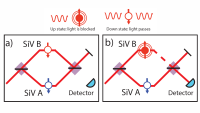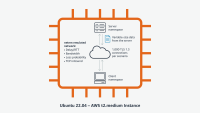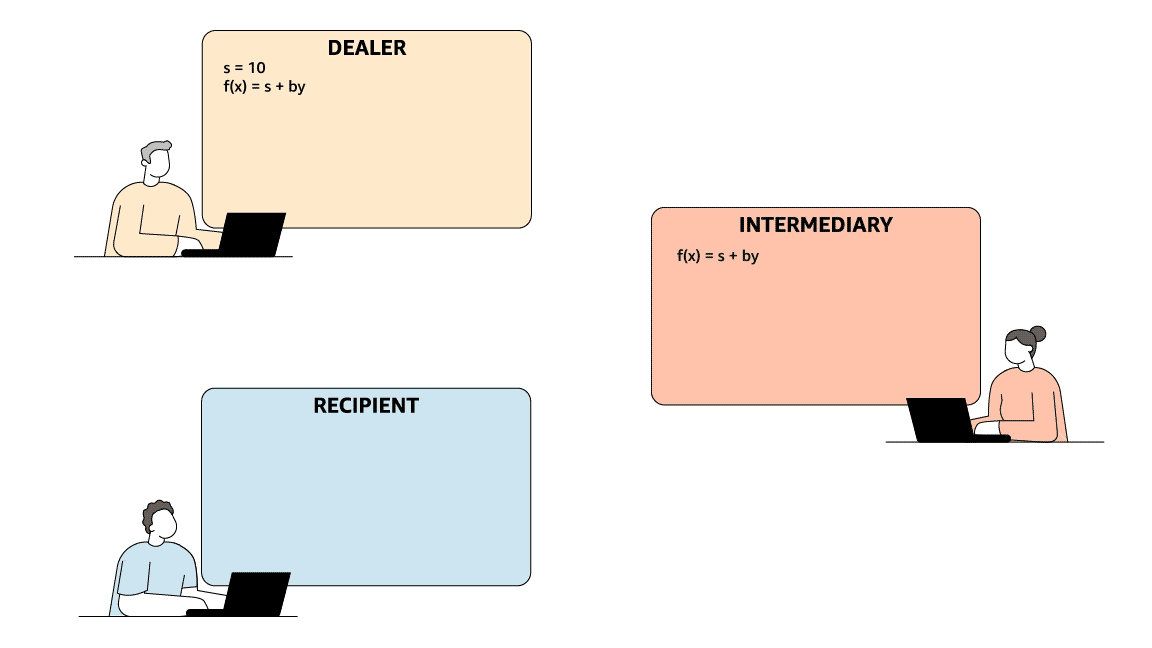Events & Conferences
QKD and authentication: Separating facts from myths

Quantum key distribution (QKD) is a technology that leverages the laws of quantum physics to securely share secret information between distant communicating parties. With QKD, quantum-mechanical properties ensure that if anyone tries to tamper with the secret-sharing process, the communicating parties will know. Keys established through QKD can then be used in traditional symmetric encryption or with other cryptographic technologies to secure communications.
“Record now, decrypt later” (RNDL) is a cybersecurity risk arising from advances in quantum computing. The term refers to the situation in which attackers record encrypted data today, even though they cannot decrypt it immediately. They store this data with the expectation that future quantum computers will be powerful enough to break the cryptographic algorithms currently securing it. Sensitive information such as financial records, healthcare data, or state secrets could be at risk, even years after it was transmitted.
Mitigating RNDL requires adopting quantum-resistant cryptographic methods, such as post-quantum cryptography (PQC) and/or quantum key distribution (QKD), to ensure confidentiality against future quantum advancements. AWS has invested in the migration to post-quantum cryptography to protect the confidentiality, integrity, and authenticity of customer data.
Quantum communication is important enough that in 2022, three of its pioneers won the Nobel Prize for physics. However, misconceptions about QKD’s role still persist. One of them is that QKD lacks practical value because it “doesn’t solve the authentication problem”. This view can obscure the broad benefits that QKD brings to secure communications when integrated properly into existing systems.
QKD should be viewed as a complement to — rather than a replacement for — existing cybersecurity frameworks. Functionally, QKD solves the same problem solved by other key establishment protocols, including the well-known Diffie-Hellman (DH) method and the module-lattice-based key encapsulation mechanism (ML-KEM), the standard recently ratified by the FIPS — but it does it in a fundamentally different way. Like those methods, QKD depends on strong authentication to defend against threats such as man-in-the-middle attacks, where an attacker poses as one of the communicating parties.
In short, key exchange protocols and authentication mechanisms are different security primitives for solving distinct problems and must be integrated together in a secure communication system.
The challenge, then, is not to give QKD an authentication mechanism but to understand how it can be integrated with other established mechanisms to strengthen the overall security infrastructure. As quantum technologies continue to evolve, it’s important to shift the conversation from skepticism about authentication to consideration of how QKD can be thoughtfully and practically implemented to address today’s and tomorrow’s cybersecurity needs — such as the need to mitigating the “record now, decrypt later” (RNDL) attack (see sidebar).
Understanding the role of authentication in QKD
When discussing authentication in the context of QKD, we focus on the classical digital channel that the parties use to exchange information about their activities on the quantum channel. This isn’t about user authentication methods, such as logging in with passwords or biometrics, but rather about authenticating the communicating entities and the data exchanged. Entity authentication ensures that the parties are who they claim to be; data authentication guarantees that the information received is the same as what was sent by the claimed source. QKD protocols include a classical-communication component that uses both authentication methods to assure the overall security of the interaction.
Entity authentication
Entity authentication is the process by which one party (the “prover”) asserts its identity, and another party (the “verifier”) validates that assertion. This typically involves a registration step, in which the verifier obtains reliable identification information about the prover, as a prelude to any further authentication activity. The purpose of this step is to establish a “root of trust” or “trust anchor”, ensuring that the verifier has a trusted baseline for future authentications.
Several entity authentication methods are in common use, each based on a different type of trust anchor:
- Public-key-infrastructure (PKI) authentication: In this method, a prover’s certificate is issued by a trusted certificate authority (CA). The verifier relies on this CA, or the root CA in a certificate chain, to establish trust. The certificate acts as the trust anchor that links the prover’s identity to its public key.
- PGP-/GPG-based (web of trust) authentication: Here, trust is decentralized. A prover’s public key is trusted if it has been vouched for by one or more trusted third parties, such as a mutual acquaintance or a public-key directory. These third parties serve as the trust anchors.
- Pre-shared-key-based (PSK) authentication: In this case, both the prover and the verifier share a secret key that was exchanged via an offline or other secure out-of-band method. The trust anchor is the method of securely sharing this key a priori, such as a secure courier or another trusted channel.
These trust anchors form the technical backbones of all authentication systems. However, all entity authentication methods are based on a fundamental assumption: the prover is either the only party that holds the critical secret data (e.g., the prover’s private key in PKI or PGP) or the only other party that shares the secret with the verifier (PSK). If this assumption is broken — e.g., the prover’s private key is stolen or compromised, or the PSK is leaked — the entire authentication process can fail.
Data authentication
Data authentication, also known as message authentication, ensures both the integrity and authenticity of the transmitted data. This means the data received by the verifier is exactly what the sender sent, and it came from a trusted source. As with entity authentication, the foundation of data authentication is the secure management of secret information shared by the communicating parties.
The most common approach to data authentication is symmetric cryptography, where both parties share a secret key. A keyed message authentication code (MAC), such as HMAC or GMAC, is used to compute a unique tag for the transmitted data. This tag allows the receiver to verify that the data hasn’t been altered during transit. The security of this method depends on the collision resistance of the chosen MAC algorithm — that is, the computational infeasibility of finding two or more plaintexts that could yield the same tag — and the confidentiality of the shared key. The authentication tag ensures data integrity, while the secret key guarantees the authenticity of the data origin.
An alternative method uses asymmetric cryptography with digital signatures. In this approach, the sender generates a signature using a private key and the data itself. The receiver, or anyone else, can verify the signature’s authenticity using the sender’s public key. This method provides data integrity through the signature algorithm, and it assures data origin authenticity as long as only the sender holds the private key. In this case, the public key serves as a verifiable link to the sender, ensuring that the signature is valid.
In both the symmetric and the asymmetric approaches, successful data authentication depends on effective entity authentication. Without knowing and trusting the identity of the sender, the verification of the data’s authenticity is compromised. Therefore, the strength of data authentication is closely tied to the integrity of the underlying entity authentication process.
Authentication in QKD
The first quantum cryptography protocol, known as BB84, was developed by Bennett and Brassard in 1984. It remains foundational to many modern QKD technologies, although notable advancements have been made since then.
QKD protocols are unique because they rely on the fundamental principles of quantum physics, which allow for “information-theoretic security.” This is distinct from the security provided by computational complexity. In the quantum model, any attempt to eavesdrop on the key exchange is detectable, providing a layer of security that classical cryptography cannot offer.
QKD relies on an authenticated classical communication channel to ensure the integrity of the data exchanged between parties, but it does not depend on the confidentiality of that classical channel. (This is why RNDL is not an effective attack against QKD). Authentication just guarantees that the entities establishing keys are legitimate, protecting against man-in-the-middle attacks.
Currently, several commercial QKD products are available, many of which implement the original BB84 protocol and its variants. These solutions offer secure key distribution in real-world applications, and they all pair with strong authentication processes to ensure the communication remains secure from start to finish. By integrating both technologies, organizations can build communication infrastructures capable of withstanding both classical and quantum threats.
Authentication in QKD bootstrap: A manageable issue
During the initial bootstrap phase of a QKD system, the authentic classical channel is established using traditional authentication methods based on PKI or PSK. As discussed earlier, all of these methods ultimately rely on the establishment of a trust anchor.
While confidentiality may need to be maintained for an extended period (sometimes decades), authentication is a real-time process. It verifies identity claims and checks data integrity in the moment. Compromising an authentication mechanism at some future point will not affect past verifications. Once an authentication process is successfully completed, the opportunity for an adversary to tamper with it has passed. That is, even if, in the future, a specific authentication mechanism used in QKD is broken by a new technology, QKD keys generated prior to that point are still safe to use, because no adversary can go back in time to compromise past QKD key generation.
This means that the reliance on traditional, non-QKD authentication methods presents an attack opportunity only during the bootstrap phase, which typically lasts just a few minutes. Given that this phase is so short compared to the overall life cycle of a QKD deployment, the potential risks posed by using authentication mechanisms are relatively minor.
Authentication after QKD bootstrap: Not a new issue
Once the bootstrap phase is complete, the QKD devices will have securely established shared keys. These keys can then be used for PSK-based authentication in future communications. In essence, QKD systems can maintain the authenticated classical communication channel by utilizing a small portion of the very keys they generate, ensuring continued secure communication beyond the initial setup phase.
It is important to note that if one of the QKD devices is compromised locally for whatever reason, the entire system’s security could be at risk. However, this is not a unique vulnerability introduced by QKD. Any cryptographic system faces similar challenges when the integrity of an endpoint is compromised. In this respect, QKD is no more susceptible to it than any other cryptographic system.
Overcoming key challenges to QKD’s role in cybersecurity
Up to now we have focused on clarifying the myths about authentication needs in QKD. Next we will discuss several other challenges in using QKD in practice.
Bridging the gap between QKD theory and implementation
While QKD protocols are theoretically secure, there remains a significant gap between theory and real-world implementations. Unlike traditional cryptographic methods, which rely on well-understood algorithms that can be thoroughly reviewed and certified, QKD systems depend on specialized hardware. This introduces complexity, as the process of reviewing and certifying QKD hardware is not yet mature.
In conventional cryptography, risks like side-channel attacks — which use runtime clues such as memory access patterns or data retrieval times to deduce secrets — are well understood and mitigated through certification processes. QKD systems are following a similar path. The European Telecommunications Standards Institute (ETSI) has made a significant move by introducing the Common Criteria Protection Profile for QKD, the first international effort to create a standardized certification framework for these systems. ISO/IEC has also published standards on security requirements and test and evaluation methods for QKD. These represent crucial steps in building the same level of trust that traditional cryptography enjoys.
Once the certification process is fully established, confidence in QKD’s hardware implementations will continue to grow, enabling the cybersecurity community to embrace QKD as a reliable, cutting-edge solution for secure communication. Until then, the focus remains on advancing the review and certification processes to ensure that these systems meet the highest security standards.
QKD deployment considerations
One of the key challenges in the practical deployment of QKD is securely transporting the keys generated by QKD devices to their intended users. While it’s accepted that QKD is a robust mechanism for distributing keys to the QKD devices themselves, it does not cover the secure delivery of keys from the QKD device to the end user (or key consumer).
This issue arises whether the QKD system is deployed within a large intranet or a small local-area network. In both cases, the keys must be transported over a non-QKD system. The standard deployment requirement is that the key delivery from the QKD system to the key consumer occurs “within the same secure site”, and the definition of a “secure site” is up to the system operator.
The best practice is to make the boundary of the secure site as small as is practical. One extreme option is to remove the need for transporting keys over classical networks entirely, by putting the QKD device and the key user’s computing hardware in the same physical unit. This eliminates the need for traditional network protocols for key transport and realizes the full security benefits of QKD without external dependency. In cases where the extreme option is infeasible or impractical, the secure site should cover only the local QKD system and the intended key consumers.
Conclusion
QKD-generated keys will remain secure even when quantum computers emerge, and communications using these keys are not vulnerable to RNDL attacks. For QKD to reach its full potential, however, the community must collaborate closely with the broader cybersecurity ecosystem, particularly in areas like cryptography and governance, risk, and compliance (GRC). By integrating the insights and frameworks established in these fields, QKD can overcome its current challenges in trust and implementation.
This collective effort is essential to ensure that QKD becomes a reliable and integral part of secure communication systems. As these collaborations deepen, QKD will be well-positioned to enhance existing security frameworks, paving the way for its adoption across industries and applications.
Events & Conferences
An inside look at Meta’s transition from C to Rust on mobile

Have you ever worked is legacy code? Are you curious what it takes to modernize systems at a massive scale?
Pascal Hartig is joined on the latest Meta Tech Podcast by Elaine and Buping, two software engineers working on a bold project to rewrite the decades-old C code in one of Meta’s core messaging libraries in Rust. It’s an ambitious effort that will transform a central messaging library that is shared across Messenger, Facebook, Instagram, and Meta’s AR/VR platforms.
They discuss taking on a project of this scope – even without a background in Rust, how they’re approaching it, and what it means to optimize for ‘developer happiness.’
Download or listen to the episode below:
You can also find the episode wherever you get your podcasts, including:
The Meta Tech Podcast is a podcast, brought to you by Meta, where we highlight the work Meta’s engineers are doing at every level – from low-level frameworks to end-user features.
Send us feedback on Instagram, Threads, or X.
And if you’re interested in learning more about career opportunities at Meta visit the Meta Careers page.
Events & Conferences
Amazon Research Awards recipients announced

Amazon Research Awards (ARA) provides unrestricted funds and AWS Promotional Credits to academic researchers investigating various research topics in multiple disciplines. This cycle, ARA received many excellent research proposals from across the world and today is publicly announcing 73 award recipients who represent 46 universities in 10 countries.
This announcement includes awards funded under five call for proposals during the fall 2024 cycle: AI for Information Security, Automated Reasoning, AWS AI, AWS Cryptography, and Sustainability. Proposals were reviewed for the quality of their scientific content and their potential to impact both the research community and society. Additionally, Amazon encourages the publication of research results, presentations of research at Amazon offices worldwide, and the release of related code under open-source licenses.
Recipients have access to more than 700 Amazon public datasets and can utilize AWS AI/ML services and tools through their AWS Promotional Credits. Recipients also are assigned an Amazon research contact who offers consultation and advice, along with opportunities to participate in Amazon events and training sessions.
“Automated Reasoning is an important area of research for Amazon, with potential applications across various features and applications to help improve security, reliability, and performance for our customers. Through the ARA program, we collaborate with leading academic researchers to explore challenges in this field,” said Robert Jones, senior principal scientist with the Cloud Automated Reasoning Group. “We were again impressed by the exceptional response to our Automated Reasoning call for proposals this year, receiving numerous high-quality submissions. Congratulations to the recipients! We’re excited to support their work and partner with them as they develop new science and technology in this important area.”
“At Amazon, we believe that solving the world’s toughest sustainability challenges benefits from both breakthrough scientific research and open and bold collaboration. Through programs like the Amazon Research Awards program, we aim to support academic research that could contribute to our understanding of these complex issues,” said Kommy Weldemariam, Director of Science and Innovation Sustainability. “The selected proposals represent innovative projects that we hope will help advance knowledge in this field, potentially benefiting customers, communities, and the environment.”
ARA funds proposals throughout the year in a variety of research areas. Applicants are encouraged to visit the ARA call for proposals page for more information or send an email to be notified of future open calls.
The tables below list, in alphabetical order by last name, fall 2024 cycle call-for-proposal recipients, sorted by research area.
AI for Information Security
| Recipient | University | Research title |
| Christopher Amato | Northeastern University | Multi-Agent Reinforcement Learning Cyber Defense for Securing Cloud Computing Platforms |
| Bernd Bischl | Ludwig Maximilian University of Munich | Improving Generative and Foundation Models Reliability via Uncertainty-awareness |
| Shiqing Ma | University Of Massachusetts Amherst | LLM and Domain Adaptation for Attack Detection |
| Alina Oprea | Northeastern University | Multi-Agent Reinforcement Learning Cyber Defense for Securing Cloud Computing Platforms |
| Roberto Perdisci | University of Georgia | ContextADBench: A Comprehensive Benchmark Suite for Contextual Anomaly Detection |
Automated Reasoning
| Recipient | University | Research title |
| Nada Amin | Harvard University | LLM-Augmented Semi-Automated Proofs for Interactive Verification |
| Suguman Bansal | Georgia Institute of Technology | Certified Inductive Generalization in Reinforcement Learning |
| Ioana Boureanu | University of Surrey | Phoebe+: An Automated-Reasoning Tool for Provable Privacy in Cryptographic Systems |
| Omar Haider Chowdhury | Stony Brook University | Restricter: An Automatic Tool for Authoring Amazon Cedar Access Control Policies with the Principle of Least Privilege |
| Stefan Ciobaca | Alexandru Ioan Cuza University | An Interactive Proof Mode for Dafny |
| João Ferreira | INESC-ID | Polyglot Automated Program Repair for Infrastructure as Code |
| Sicun Gao | University Of California, San Diego | Monte Carlo Trees with Conflict Models for Proof Search |
| Mirco Giacobbe | University of Birmingham | Neural Software Verification |
| Tobias Grosser | University of Cambridge | Synthesis-based Symbolic BitVector Simplification for Lean |
| Ronghui Gu | Columbia University | Scaling Formal Verification of Security Properties for Unmodified System Software |
| Alexey Ignatiev | Monash University | Huub: Next-Gen Lazy Clause Generation |
| Kenneth McMillan | University of Texas At Austin | Synthesis of Auxiliary Variables and Invariants for Distributed Protocol Verification |
| Alexandra Mendes | University of Porto | Overcoming Barriers to the Adoption of Verification-Aware Languages |
| Jason Nieh | Columbia University | Scaling Formal Verification of Security Properties for Unmodified System Software |
| Rohan Padhye | Carnegie Mellon University | Automated Synthesis and Evaluation of Property-Based Tests |
| Nadia Polikarpova | University Of California, San Diego | Discovering and Proving Critical System Properties with LLMs |
| Fortunat Rajaona | University of Surrey | Phoebe+: An Automated-Reasoning Tool for Provable Privacy in Cryptographic Systems |
| Subhajit Roy | Indian Institute of Technology Kanpur | Theorem Proving Modulo LLM |
| Gagandeep Singh | University of Illinois At Urbana–Champaign | Trustworthy LLM Systems using Formal Contracts |
| Scott Stoller | Stony Brook University | Restricter: An Automatic Tool for Authoring Amazon Cedar Access Control Policies with the Principle of Least Privilege |
| Peter Stuckey | Monash University | Huub: Next-Gen Lazy Clause Generation |
| Yulei Sui | University of New South Wales | Path-Sensitive Typestate Analysis through Sparse Abstract Execution |
| Nikos Vasilakis | Brown University | Semantics-Driven Static Analysis for the Unix/Linux Shell |
| Ping Wang | Stevens Institute of Technology | Leveraging Large Language Models for Reasoning Augmented Searching on Domain-specific NoSQL Database |
| John Wawrzynek | University of California, Berkeley | GPU-Accelerated High-Throughput SAT Sampling |
AWS AI
| Recipient | University | Research title |
| Panagiotis Adamopoulos | Emory University | Generative AI solutions for The Spillover Effect of Fraudulent Reviews on Product Recommendations |
| Vikram Adve | University of Illinois at Urbana–Champaign | Fellini: Differentiable ML Compiler for Full-Graph Optimization for LLM Models |
| Frances Arnold | California Institute of Technology | Closed-loop Generative Machine Learning for De Novo Enzyme Discovery and Optimization |
| Yonatan Bisk | Carnegie Mellon University | Useful, Safe, and Robust Multiturn Interactions with LLMs |
| Shiyu Chang | University of California, Santa Barbara | Cut the Crap: Advancing the Efficient Communication of Multi-Agent Systems via Spatial-Temporal Topology Design and KV Cache Sharing |
| Yuxin Chen | University of Pennsylvania | Provable Acceleration of Diffusion Models for Modern Generative AI |
| Tianlong Chen | University of North Carolina at Chapel Hill | Cut the Crap: Advancing the Efficient Communication of Multi-Agent Systems via Spatial-Temporal Topology Design and KV Cache Sharing |
| Mingyu Ding | University of North Carolina at Chapel Hill | Aligning Long Videos and Language as Long-Horizon World Models |
| Nikhil Garg | Cornell University | Market Design for Responsible Multi-agent LLMs |
| Jessica Hullman | Northwestern University | Human-Aligned Uncertainty Quantification in High Dimensions |
| Christopher Jermaine | Rice University | Fast, Trusted AI Using the EINSUMMABLE Compiler |
| Yunzhu Li | Columbia University | Physics-Informed Foundation Models Through Embodied Interactions |
| Pattie Maes | Massachusetts Institute of Technology | Understanding How LLM Agents Deviate from Human Choices |
| Sasa Misailovic | University of Illinois at Urbana–Champaign | Fellini: Differentiable ML Compiler for Full-Graph Optimization for LLM Models |
| Kristina Monakhova | Cornell University | Trustworthy extreme imaging for science using interpretable uncertainty quantification |
| Todd Mowry | Carnegie Mellon University | Efficient LLM Serving on Trainium via Kernel Generation |
| Min-hwan Oh | Seoul National University | Mutually Beneficial Interplay Between Selection Fairness and Context Diversity in Contextual Bandits |
| Patrick Rebeschini | University of Oxford | Optimal Regularization for LLM Alignment |
| Jose Renau | University of California, Santa Cruz | Verification Constrained Hardware Optimization using Intelligent Design Agentic Programming |
| Vilma Todri | Emory University | Generative AI solutions for The Spillover Effect of Fraudulent Reviews on Product Recommendations |
| Aravindan Vijayaraghavan | Northwestern University | Human-Aligned Uncertainty Quantification in High Dimensions |
| Wei Yang | University of Texas at Dallas | Optimizing RISC-V Compilers with RISC-LLM and Syntax Parsing |
| Huaxiu Yao | University of North Carolina at Chapel Hill | Aligning Long Videos and Language as Long-Horizon World Models |
| Amy Zhang | University of Washington | Tools for Governing AI Agent Autonomy |
| Ruqi Zhang | Purdue University | Efficient Test-time Alignment for Large Language Models and Large Multimodal Models |
| Zheng Zhang | Rutgers University-New Brunswick | AlphaQC: An AI-powered Quantum Circuit Optimizer and Denoiser |
AWS Cryptography
| Recipient | University | Research title |
| Alexandra Boldyreva | Georgia Institute of Technology | Quantifying Information Leakage in Searchable Encryption Protocols |
| Maria Eichlseder | Graz University of Technology, Austria | SALAD – Systematic Analysis of Lightweight Ascon-based Designs |
| Venkatesan Guruswami | University of California, Berkeley | Obfuscation, Proof Systems, and Secure Computation: A Research Program on Cryptography at the Simons Institute for the Theory of Computing |
| Joseph Jaeger | Georgia Institute of Technology | Analyzing Chat Encryption for Group Messaging |
| Aayush Jain | Carnegie Mellon | Large Scale Multiparty Silent Preprocessing for MPC from LPN |
| Huijia Lin | University of Washington | Large Scale Multiparty Silent Preprocessing for MPC from LPN |
| Hamed Nemati | KTH Royal Institute of Technology | Trustworthy Automatic Verification of Side-Channel Countermeasures for Binary Cryptographic Programs using the HoIBA libary |
| Karl Palmskog | KTH Royal Institute of Technology | Trustworthy Automatic Verification of Side-Channel Countermeasures for Binary Cryptographic Programs using the HoIBA libary |
| Chris Peikert | University of Michigan, Ann Arbor | Practical Third-Generation FHE and Bootstrapping |
| Dimitrios Skarlatos | Carnegie Mellon University | Scale-Out FHE LLMs on GPUs |
| Vinod Vaikuntanathan | Massachusetts Institute of Technology | Can Quantum Computers (Really) Factor? |
| Daniel Wichs | Northeastern University | Obfuscation, Proof Systems, and Secure Computation: A Research Program on Cryptography at the Simons Institute for the Theory of Computing |
| David Wu | University Of Texas At Austin | Fast Private Information Retrieval and More using Homomorphic Encryption |
Sustainability
| Recipient | University | Research title |
| Meeyoung Cha | Max Planck Institute | Forest-Blossom (Flossom): A New Framework for Sustaining Forest Biodiversity Through Outcome-Driven Remote Sensing Monitoring |
| Jingrui He | University of Illinois at Urbana–Champaign | Foundation Model Enabled Earth’s Ecosystem Monitoring |
| Pedro Lopes | University of Chicago | AI-powered Tools that Enable Engineers to Make & Re-make Sustainable Hardware |
| Cheng Yaw Low | Max Planck Institute | Forest-Blossom (Flossom): A New Framework for Sustaining Forest Biodiversity Through Outcome-Driven Remote Sensing Monitoring |
Events & Conferences
Independent evaluations demonstrate Nova Premier’s safety

AI safety is a priority at Amazon. Our investment in safe, transparent, and responsible AI (RAI) includes collaboration with the global community and policymakers. We are members of and collaborate with organizations such as the Frontier Model Forum, the Partnership on AI, and other forums organized by government agencies such as the National Institute of Standards and Technology (NIST). Consistent with Amazon’s endorsement of the Korea Frontier AI Safety Commitments, we published our Frontier Model Safety Framework earlier this year.
During the development of the Nova Premier model, we conducted a comprehensive evaluation to assess its performance and safety. This included testing on both internal and public benchmarks and internal/automated and third-party red-teaming exercises. Once the final model was ready, we prioritized obtaining unbiased, third-party evaluations of the model’s robustness against RAI controls. In this post, we outline the key findings from these evaluations, demonstrating the strength of our testing approach and Amazon Premier’s standing as a safe model. Specifically, we cover our evaluations with two third-party evaluators: PRISM AI and ActiveFence.
Evaluation of Nova Premier against PRISM AI
PRISM Eval’s Behavior Elicitation Tool (BET) dynamically and systematically stress-tests AI models’ safety guardrails. The methodology focuses on measuring how many adversarial attempts (steps) it takes to get a model to generate harmful content across several key risk dimensions. The central metric is “steps to elicit” — the number of increasingly sophisticated prompting attempts required before a model generates an inappropriate response. A higher number of steps indicates stronger safety measures, as the model is more resistant to manipulation. The PRISM risk dimensions (inspired by the MLCommons AI Safety Benchmarks) include CBRNE weapons, violent crimes, non-violent crimes, defamation, and hate, amongst several others.
Using the BET Eval tool and its V1.0 metric, which is tailored toward non-reasoning models, we compared the recently released Nova models (Pro and Premier) to the latest models in the same class: Claude (3.5 v2 and 3.7 non-reasoning) and Llama4 Maverick, all available through Amazon Bedrock. PRISM BET conducts black-box evaluations (where model developers don’t have access to the test prompts) of models integrated with their API. The evaluation conducted with BET Eval MAX, PRISM’s most comprehensive/aggressive testing suite, revealed significant variations in safety against malicious instructions. Nova models demonstrated superior overall safety performance, with an average of 43 steps for Premier and 52 steps for Pro, compared to 37.7 for Claude 3.5 v2 and fewer than 12 steps for other models in the comparison set (namely, 9.9 for Claude3.7, 11.5 for Claude 3.7 thinking, and 6.5 for Maverick). This higher step count suggests that on average, Nova’s safety guardrails are more sophisticated and harder to circumvent through adversarial prompting. The figure below presents the number of steps per harm category evaluated through BET Eval MAX.
The PRISM evaluation provides valuable insights into the relative safety of different Amazon Bedrock models. Nova’s strong performance, particularly in hate speech and defamation resistance, represents meaningful progress in AI safety. However, the results also highlight the ongoing challenge of building truly robust safety measures into AI systems. As the field continues to evolve, frameworks like BET will play an increasingly important role in benchmarking and improving AI safety. As a part of this collaboration Nicolas Miailhe, CEO of PRISM Eval, said, “It’s incredibly rewarding for us to see Nova outperforming strong baselines using the BET Eval MAX; our aim is to build a long-term partnership toward safer-by-design models and to make BET available to various model providers.” Organizations deploying AI systems should carefully consider these safety metrics when selecting models for their applications.
Manual red teaming with ActiveFence
The AI safety & security company ActiveFence benchmarked Nova Premier on Bedrock on prompts distributed across Amazon’s eight core RAI categories. ActiveFence also evaluated Claude 3.7 (non-reasoning mode) and GPT 4.1 API on the same set. The flag rate on Nova Premier was lower than that on the other two models, indicating that Nova Premier is the safest of the three.
| Model | 3P Flag Rate [↓ is better] |
| Nova Premier | 12.0% |
| Sonnet 3.7 (non-reasoning) | 20.6% |
| GPT4.1 API | 22.4% |
“Our role is to think like an adversary but act in service of safety,” said Guy Paltieli from ActiveFence. “By conducting a blind stress test of Nova Premier under realistic threat scenarios, we helped evaluate its security posture in support of Amazon’s broader responsible-AI goals, ensuring the model could be deployed with greater confidence.”
These evaluations conducted with PRISM and ActiveFence give us confidence in the strength of our guardrails and our ability to protect our customers’ safety when they use our models. While these evaluations demonstrate strong safety performance, we recognize that AI safety is an ongoing challenge requiring continuous improvement. These assessments represent a point-in-time snapshot, and we remain committed to regular testing and enhancement of our safety measures. No AI system can guarantee perfect safety in all scenarios, which is why we maintain monitoring and response systems after deployment.
Acknowledgments: Vincent Ponzo, Elyssa Vincent
-
Funding & Business6 days ago
Kayak and Expedia race to build AI travel agents that turn social posts into itineraries
-
Jobs & Careers6 days ago
Mumbai-based Perplexity Alternative Has 60k+ Users Without Funding
-
Mergers & Acquisitions6 days ago
Donald Trump suggests US government review subsidies to Elon Musk’s companies
-
Funding & Business6 days ago
Rethinking Venture Capital’s Talent Pipeline
-
Jobs & Careers6 days ago
Why Agentic AI Isn’t Pure Hype (And What Skeptics Aren’t Seeing Yet)
-
Funding & Business3 days ago
Sakana AI’s TreeQuest: Deploy multi-model teams that outperform individual LLMs by 30%
-
Funding & Business6 days ago
From chatbots to collaborators: How AI agents are reshaping enterprise work
-
Tools & Platforms6 days ago
Winning with AI – A Playbook for Pest Control Business Leaders to Drive Growth
-
Jobs & Careers4 days ago
Ilya Sutskever Takes Over as CEO of Safe Superintelligence After Daniel Gross’s Exit
-
Funding & Business4 days ago
Dust hits $6M ARR helping enterprises build AI agents that actually do stuff instead of just talking



















































